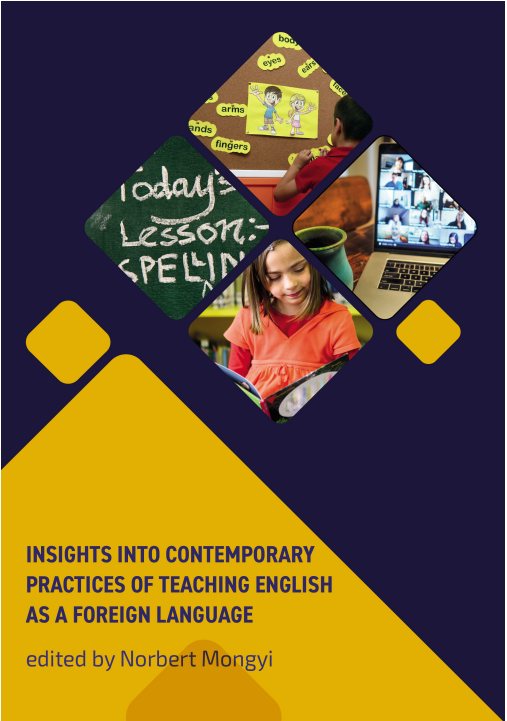Insights into Contemporary Practices of Teaching English as a Foregin Language
Tartalom
Editorial foreword
When the idea of putting together a volume in which authors share their classroom practices, strategies, techniques, or their reflections of the above regarding teaching English as a foreign language (EFL) came up, topics from the context of communicative language teaching in the 21st century were discussed. As a starting point, it was agreed by the authors that since the 1990s, the communicative approach has been widely implemented across EFL teaching contexts. Prasad (2013) argues that since current communicative language teaching theory and practice draws on a number of different educational paradigms and traditions (including second language acquisition research, collaborative learning, competency-based learning, and content based instruction), there is no single or agreed upon set of practices that characterize current communicative language teaching. In addition, when language teaching does not only take place in physical classroom settings but in Web 2.0 environments where technologies and tools enable users to create, share, and collaborate on digital content, rather than just consume it, the input that learners need to process is endless and comes in diverse forms. Therefore, “literacy should involve all various ways of communication to make meanings (i.e. through combinations of linguistic, gestural, audio, visual, tactile and spatial semiotic modes), as well as an appreciation of diversity of textual, contextual, social and cultural conventions that influence the use of these modes for different people in different situations” (Kustini et al. 2020, p. 671). In order for learning to be ubiquitous (the learning processes take place both inside and outside the classrooms), teachers of EFL become the facilitators of language learning. It should be their role as learners using their mobile devices can access a multidute of linguistic input.
In what follows, Alexovics aims at answering the questions of what and how teachers of English should use in order to develop their learners’ literacies, motivate them and provide them with authentic materials so as to foster the development of their command of English. For teachers to be able to effectively develop learners’ literacies in the information-based society of the 21st century, the development of multiperspective competence should be emphasised. The Content and Language Integrated Learning (CLIL) approach and its relationship to history education are highlighted, focusing on the intersection of English language teaching, history education, and the development of multiperspective competence in the paper of Fodor, Tóth and Máté. Next, Kocsis argues that learners require rich exposure to new language forms while working on familiar language in order to develop accuracy and fluency. In her paper, she sheds light on an important element of online participatory culture: memes and their language-learning potential. Her paper provides historical and theoretical aspects to the study of Internet memes, describes their characteristic features and proposes some practical teaching ideas for their exploitation in the foreign language classroom, with particular focus on teaching EFL. Then, another constituent of online communication is integrated into teaching EFL. Mongyi describes using a virtual message board with the purpose of supporting information-based English language teaching. In his paper, the teaching of cross-curricular content using Padlet within the framework of content-based language instruction is addressed. Afterwards, Sebőkné brings another important facet of being the facilitator of language learning to the readers’ attention. Her paper discusses the significance of talent management and addresses key challenges in identifying and defining giftedness, while sharing some practical ways of using cooperative teaching strategies and differentiation in classroom work, in order to implement talent management in English language teaching. The importance of learning English in a community is described in the paper of Szabó. Her paper addresses the importance of learner engagement in project-based learning, and discusses how learners use different 21st century skills and multiple intelligences during the process of creation while developing positive group dynamics. Ultimately, the paperS closing the volume direct readers’ attention to the characteristics of learners whose learning experiences take place both offline and virtually. The first paper of Szőke-Milinte should be considered as a starting point when it comes to understanding the learning habits of Generation Z, therefore, serves as an underpinning to the classroom practices and teachers’ reflections shared in the papers below. Szőke-Milinte’s second paper aims at redefining information literacy from a pedagogical point of view in order to support the work of teaching professionals in the context of the information-based society when designing and planning course contents together with learning outcomes, implementing learning activities and communication.
As the title suggests, the present volume offers its readers insights into the contemporary practices of teaching EFL. As a result, the education practitioners sharing their reflections here aim at inviting their readers (teachers, educators or teacher trainees) to adopt whatever is possible and implement these ideas, techniques or approaches into their professional practice of language teaching.
References
Kustini, S., Suherdi, D. & Musthafa, B. (2020). Moving towards 21st Century English Language Teaching: Developing ESP multiliteracies-based materials. In: Proceedings of the 4th International Conference on Language, Literature, Culture, and Education (ICOLLITE 2020). pp. 670-675.
Prasad, B. B. (2013). Communicative Language Teaching in 21st Century ESL Classroom.
Norbert Mongyi
Fejezetek
-
Editorial foreword
-
Ethical Choices in Using Internet-based Materials for Language Teaching
-
Content and Language Integrated Learning in History Education
-
Using Memes for Skills Development in the Foreign Language Classroom
-
Developing Information Literacy via CLIL in Teaching English as a Foreign Language
-
Talent Management in Foreign Language Education
-
Developing Group Dynamics with Project-Based Learning in the EFL Classroom
-
Getting to know Generation Z – the learning style of Generation Z
-
Data, information and knowledge in the information society
-
Publications and activities of the Vitéz János Teacher Training Center

Letöltések
Megjelent
License

This work is licensed under a Creative Commons Attribution-ShareAlike 4.0 International License.



